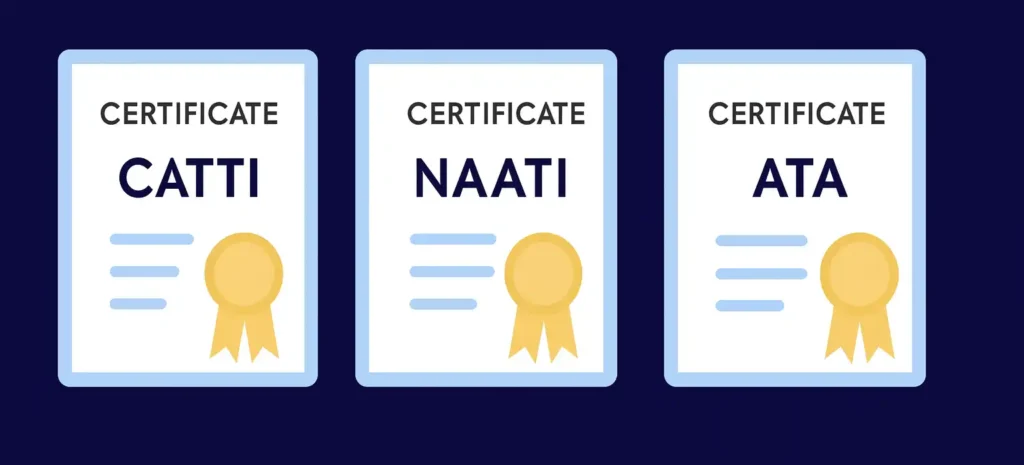Curious about CATTI, NAATI, or ATA? Compare exam formats, costs, and prep tips to choose the best Chinese translator certification for your goals.
1. What Are the Main Chinese Translator Certifications?
When it comes to Chinese translator credentials, three major options stand out:
| Certification | Region / Authority | Levels / Structure | Pass Rate | Key Features |
|---|
| CATTI | China (Ministry of Human Resources) | Level 3 (entry), Level 2, Level 1 (highest) | ~10% for Level 2 | China’s official translator exam; known for rigor; used for domestic positions. |
| NAATI | Australia (National Accreditation Authority) | Certified Translator / Interpreter | Varies by language, moderate | Required for migration; includes practical tasks and ethical scenarios. |
| ATA | USA (American Translators Association) | Single exam per language pair | <20% | Open-book; focuses on nuanced, fluent translation; globally respected. |

2. Which Certificate Is Right for Me?
As a general rule:
- Want to work in China? → Go for CATTI.
- Planning to migrate or work in Australia? → You’ll need NAATI.
- Targeting international freelance work or U.S. agencies? → ATA is your best bet.
On average, Chinese-English translators may choose more than one certificate over time depending on evolving work needs.
3. How Long Does It Take to Prepare?
In total, preparation time varies:
- CATTI Level 2: 6–12 months for those with strong bilingual skills.
- NAATI: Around 3–6 months with structured training.
- ATA: At least 6 months due to the emphasis on advanced writing.
Many candidates recommend pairing study with real translation projects or mock tests to sharpen practical skills.
READ MORE:Why is Chinese Translation Difficult?
🧠 How to prepare for Translation Exam?
1. CATTI (Level 2) — Deep Dive into Terminology and Speed
“CATTI isn’t just about accuracy—it’s about speed under pressure,” says Li Wenhua, a senior Chinese-English interpreter.
✅ Recommendation:
- Read Chinese government reports and official white papers regularly.
- Practice timed translation exercises—CATTI Level 2 requires completing both written translation and interpretation tasks within strict time limits.
- Subscribe to terminology databases like TERMCAT or China National Knowledge Infrastructure (CNKI) to stay current.
2. NAATI — Ethics and Real-Life Scenarios Matter
“NAATI tests your ability to translate in real-life situations, not just your language skills,” says Michelle Zhang, NAATI-certified trainer.
✅ Recommendation:
- Study the Ethics and Code of Conduct from NAATI.
- Role-play with friends or mentors: simulate interpreting at hospitals, police stations, or immigration offices.
- Enroll in mock test workshops provided by NAATI-endorsed institutions.
3. ATA — Writing Quality Is Everything
“ATA expects fluency and professional writing tone, not just a literal translation,” notes John Holcomb, an ATA-certified translator with 15+ years of experience.
✅ Recommendation:
- Analyze award-winning translation samples from ATA’s database.
- Join peer review groups—getting feedback on nuance and tone is crucial.
- Practice editing your own work—ATA values readability, cohesion, and natural phrasing.
As a general rule, most certified translators agree:
“Nothing beats hands-on practice. Take on volunteer translation projects or create your own mock assignments to simulate real deadlines and topics.”
4. Do I Need a Degree to Get Certified?
While a degree helps, especially in language or translation, it’s not mandatory for NAATI or ATA. CATTI also allows non-degree holders to take the exam, though experience is advised.
In a general rule, what matters most is practical translation ability and the ability to pass a rigorous exam.
5. How Much Does Certification Cost?
Here’s an overview (in USD, as of 2024):
On average, Chinese translators invest around $800–$1200 for full preparation including materials, courses, and exam fees. Additional costs may include memberships, refresher workshops, and practice exams—but many professionals see this as a worthwhile long-term investment in credibility and career growth.

Whether you aim to pass CATTI in China, obtain NAATI for migration purposes, or achieve ATA for international recognition, each Chinese translator certification is a powerful way to elevate your professional standing. Preparation may take months, but the long-term benefits—credibility, higher pay, and better job opportunities—are well worth the effort.
🌟 Ready to take the next step? Don’t just dream about becoming a certified translator—start preparing today. If you’d like expert guidance, structured practice, or personalized tips for exam success, reach out to us and let’s map out your certification journey together.
